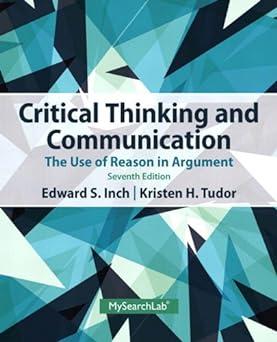7. Carla Kiiskila, a resident of a section of north Wallingford that seems pretty tranquil until you
Question:
7. Carla Kiiskila, a resident of a section of north Wallingford that seems pretty tranquil until you try to cross the street, wrote to the Engineering Department to complain about the hazards of N. 50th Street at Sunnyside Avenue . . . . Kiiskila complains that she has several times narrowly escaped being hit and had to run for the curb to get across 50th. So the Engineering Department’s van Gelder came out to examine the intersection. No doubt there’s a danger and a problem there, he admits. [One citizen] got the Engineering folks to try crossing at the speed of an 85-year-old, and proved it was impossible. She unwittingly proved her point afterward, when she went to cross back (at normal speed) and very nearly got hit by a speeding car that spun broadside to avoid hitting her.
Eric Scigliano, “How Can a Citizen Cross the Road?” The Weekly (August 27–September 2, 1986): 22. For each of the following arguments, A. Identify what type of argument it is: quasilogical, analogy, generalization or example, cause, coexistential, or dissociation.
B. Identify the evidence, claim, and inference. (Remember that the inference is often implicit.
If it is not explicitly stated, supply it.)
C. Provide two questions that you might use to test the argument.
Note: It is important to remember that sometimes an argument can fall into more than one classification.
For example, an argument might make a causal claim based on a comparison (analogy), or it might use examples to show that a causal relationship exists. Note, too, that you will find some of these arguments quite controversial. They should be interpreted as sympathetically as possible, that is, in line with what the author intended. The three steps described are demonstrated in regard to the following argument:
But as our Nation has succeeded in setting a course for financial responsibility, students across the country have struggled to do the same. The rising price of higher education puts college out of reach for many promising young people, and it saddles those who do get an education with an unsustainable debt, a debt that causes them to delay buying their first home, put off having children, or give up the goal of starting a business. Today Americans have more than
$1 trillion in student loan debt. There is more student loan debt than credit card debt, and the average graduate owes more than $25,000 when they get out of school. I think a college education should free young people to achieve their dreams, not saddle them with crushing debt for the rest of their lives.
Senator Harry Reid, “Student Loans,” Congressional Record, May 22, 2013, S3202.
A. This is an argument from cause.
B. Evidence: Loan debt is more than $1 trillion. More is owed in student loans than all the credit card debt in the United States. The average graduate owes more than $25,000.
Claim: College debt is saddling students with crushing debt for the rest of their lives.
Inference: The rising price of education limits access for some students while resulting in crushing debt for others that prevents them buying a house, having children, or starting a business.
Step by Step Answer:

Critical Thinking And Communication The Use Of Reason In Argument
ISBN: 9780205925773
7th Edition
Authors: Edward S. Inch, Kristen H. Tudor






